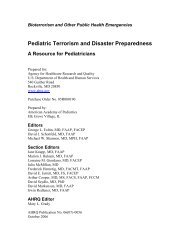(HPP) Performance Measure Manual
(HPP) Performance Measure Manual
(HPP) Performance Measure Manual
You also want an ePaper? Increase the reach of your titles
YUMPU automatically turns print PDFs into web optimized ePapers that Google loves.
<strong>HPP</strong> 14.1<br />
Key Definitions<br />
Pharmaceutical Cache: A collection of<br />
pharmaceuticals, antidotes, and medical<br />
supplies designed to provide rapid delivery of a<br />
broad spectrum of assets for an ill-defined<br />
threat in the early hours of an event.<br />
Prophylactic pharmaceutical caches can protect<br />
healthcare workers from illness, allowing them<br />
to continue delivering important healthcare<br />
services. In addition, providing prophylaxis to<br />
healthcare workers’ families enhances response<br />
by theoretically allowing the worker to remain<br />
on duty rather than care for an ill family<br />
member.<br />
Healthcare Workers’ Families: Family members<br />
of healthcare workers who may benefit from<br />
prophylaxis or treatment theoretically allowing<br />
the worker to remain on duty rather than care<br />
for ill family members.<br />
Prophylaxis: A medical or public health<br />
procedure undertaken to prevent, rather than<br />
treat or cure, a disease.<br />
Post-exposure Prophylaxis: Treatment started<br />
immediately after exposure to a pathogen to<br />
prevent infection by the pathogen and the<br />
development of disease.<br />
Personal Protective Equipment (PPE):<br />
Specialized clothing or equipment worn by an<br />
employee for protection against infectious<br />
materials. PPE such as masks and gloves can<br />
protect healthcare workers from illness and<br />
injury allowing them to continue delivering<br />
important healthcare services. Ensuring a<br />
sufficient supply of PPE requires a number of<br />
steps be taken during emergency preparedness<br />
including: determining the PPE need, assessing<br />
in-facility stocks of PPE, comparing need and<br />
stock to identify any PPE gaps, and then<br />
developing procedures for obtaining the gap<br />
amount should you need it (e.g., a resource<br />
request via the ICS resource management<br />
system).<br />
Surge: The state in which the capacity (volume<br />
of patients and requirements) and capabilities<br />
(the ability to treat or manage a medical<br />
condition) of a healthcare entity are above<br />
baseline requirements.<br />
Surge Capability: The ability to manage patients<br />
requiring unusual or very specialized medical<br />
evaluation and care. Requirements span the<br />
range of specialized medical and public health<br />
services (expertise, information, procedures,<br />
equipment, or personnel) that are not normally<br />
available at the location where they are needed.<br />
It also includes patient problems that require<br />
special intervention to protect medical<br />
providers, other patients, and the integrity of<br />
the healthcare organization.<br />
Surge Capacity: The ability to evaluate and care<br />
for a markedly increased volume of patients—<br />
one that challenges or exceeds normal<br />
operating capacity. Requirements may extend<br />
beyond direct patient care to include other<br />
medical tasks, such as extensive laboratory<br />
studies or epidemiologic investigations.<br />
Responder Safety and Health<br />
Pre-Incident<br />
Healthcare<br />
Response<br />
Preparedness<br />
Hospital Preparedness Program (<strong>HPP</strong>) <strong>Performance</strong> <strong>Measure</strong> <strong>Manual</strong>,<br />
Guidance for Using the New <strong>HPP</strong> <strong>Performance</strong> <strong>Measure</strong>s Page | 47
















